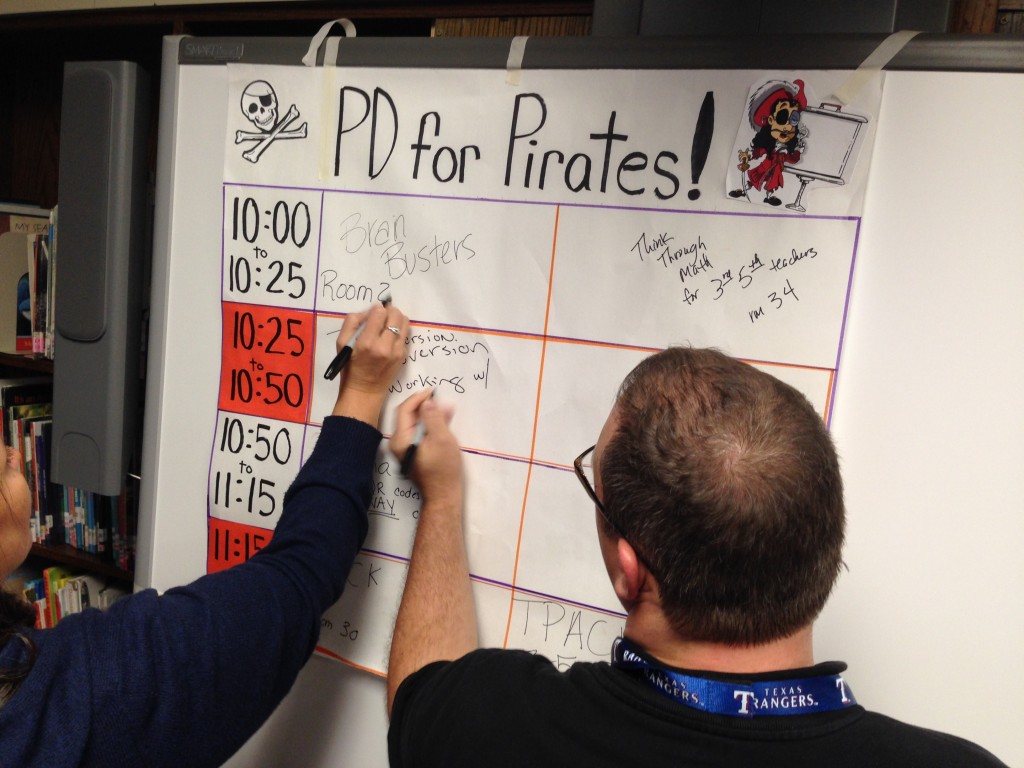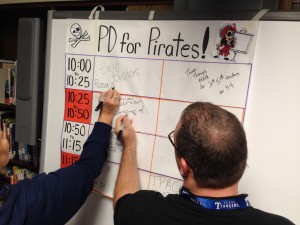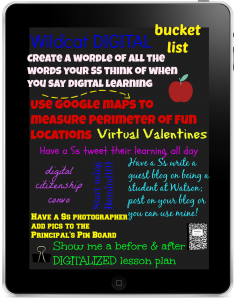
(Thanks George, for this month’s post & prompt!)
There has been a lot of talk on the idea that education as a whole takes a long time to change. As an educator, this is a challenging notion, since we are seeing many people doing some amazing things that did not exist when I was a student. Change is happening but sometimes it is hard to see when you are in the middle of the process.
Some things are out of the hands of schools. Budgets and government decisions can make creating new and better learning environments for students tough, but not impossible. Educators are not powerless, and in some cases, more powerful that ever. The story of education can not only be told from the perspective of educators, but also from the students that are currently in the system. Although there is still a lot of work to do (as there always will be in organizations that focus on continuous learning and have an emphasis on becoming “innovative”), there are also opportunities in education, now more than ever, that we will need to take advantage of and create a different path.
Here are some of the challenges we have had in the past and how we can tackle them
1. Isolation is the enemy of innovation.
Education has traditionally been an isolating profession where we get some time together, but not nearly enough. Even if we wanted to change this significantly, in most cases, the current physical structures do not allow us to work with other educators. Some administrators have been very innovative in their planning of teacher prep time and have embedded collaboration time into the regular school day, but it is not necessarily enough to make a significant impact.
How so many educators have shifted this “norm” is by using social media spaces to connect and learn from educators all over the world, and making a significant difference in their own classrooms, and creating much more engaging and empowering learning spaces. Isolation is now a choice educators make. Where the shift really has to happen is using things like Twitter is for educators to connect and share learning that is happening with educators in their own school. I challenged people to do the following (as shared in this visual from Meredith Johnson);

We need to make this happen and create transparency in our own classrooms.
How does a song like “Gangnam Style” go so viral that most people around the world not only know the words but the dance moves? Social media. If a song can spread so quickly, so can great learning.
Make it go viral.
2. A continuous focus on what is wrong, as opposed to what is right.
Think about the traditional practice of what school has done with many of our students. If they struggle with the subject of math, we often send the more math homework to do at home. Does this really make sense? If they are struggling at school, making them struggle at home with the same content is often counter-intuitive. It is not that we shouldn’t struggle, but it is important that we are very thoughtful of how we spend our energy.
The shift that has happened with not only our students, but also our schools, is focusing upon building upon strengths as opposed to focusing solely on weaknesses. This is imperative as building upon strengths often helps us to not only build competence, but also confidence which leads us to the mindset that we are more open to tackle our other challenges along the way.
I love this quote from Forbes on putting people in the right positions to be successful:
Leadership is a privilege, not a right, and we need to treat it as such. Leadership means encouraging people to live up to their fullest potential and find the path they love. That, and only that, will create a strong culture and sustainable levels of innovation.
Many organizations outside of education are hiring not on need, but finding the best people and empowering them based upon their strengths. Schools should try to do their best to follow suit and put people to be in the best situations to not only do well, but to lead.
3. Experience is a very powerful teacher.
I remember sitting and listening to Bruce Dixon at a conference and something he said has always stuck out to me:
In no other profession in the world do you sit and watch someone else do your job for 16 years before you go and do it yourself.
Wow. That is a powerful message and shows why so many new teachers aren’t coming into school with all of these “innovative ideas” and changing our school system like so many people predicted. Many educators simply replicate their experience as a student. If you think about it, at least one-third of many teachers educational experience is as a student, not a teacher. That is a tough thing to overcome, but not impossible.
Innovation has no age barrier, and if we can tweak the experience for educators in their professional learning, they are more likely to change the experience for their students. Writing ideas about “21st century classrooms” on gigantic pieces of paper with a felt marker is not going to create cultural shifts; changing experiences will.
People are starting to look differently at professional learning, and create experiences that are much different from what I first experienced as a teacher. I think a major reason for this shift (going back to point 1) is that educators are seeing the shift in practices in so many other organizations, and are trying to create a different practice where more educators are not really focused on teaching as much as they are about learning. This empathy is crucial since to become a master teacher, you must become a master learner.
Changing experiences to shift the focus on the learner from the teacher helps to disrupt routine. If you would want to create an environment where students would want to be a part of your classroom, we have to experience what learning could look like for ourselves and start from a point of empathy.
One shift that was not mentioned was the mindset of looking at obstacles as opportunities. As mentioned earlier, not everything is in our control, but as educators know, they can make an impact every single day. It is not always easy, and teaching can be a very daunting and tiring job, but I believe that every day we can make a difference if we choose. Having that mindset is the only way that we will ever truly be able to make a powerful change for ourselves and our students.
For this month’s prompt, write about how you already are, or are going to, address the challenges discussed above.
Amber

 When planning for your staff development or professional development or growth opportunity…do you differentiate for your teachers?
When planning for your staff development or professional development or growth opportunity…do you differentiate for your teachers?
I know, I know…with everything else on your plate, now you’re supposed to add that to your list of to do’s? The answer is yes, if you want them to be completely dialed in and connected. In the same way that we expect our teachers to meet the needs of the learners in their class, we as administrators need to recognize the different levels of abilities and experiences on our staff. A differentiated approach to PD is needed to meet the diversity of teacher needs. PD should always be an evolving process of reflection and growth, and the way to accomplish that, is to get creative with how it’s planned and delivered.
Meeting teachers where they are isn’t nearly as complicated as it sounds. Depending on what you are discussing, teachers can be grouped according to familiarity or confidence in the topic. This can be discovered through a needs assessment or of their own volition. Allowing teachers to feel invested and providing a choice in what they are learning will almost certainly pay dividends in the long run. This will also reinforce your expectations within the classroom.
Grouping teachers is one way of differentiating. What else can you do?
- Give options in what your teachers are discussing, #edcamp style. I’ve even “prepped” teachers with a couple of topics that I knew that I wanted to see covered, but left most of the board blank, for their input.
- Allow conversations, not just “sit & get” sessions.
- Flip your meetings, to make the discussions more valid & transparent. Allow teacher voice!
- Let your groups of ability leveled learners be led by members of your own staff. Call on the experience in your building!
- Create a bucket list of activities you’d like to see in classrooms.

Supporting teachers begins with knowing that we should meet their individual needs in their own learning and growth. We no longer can be ok with the status quo, or a one size fits all mentality when it comes to PD. As the leader, it is up to you ensure that each educator has what they need in order to be the very best that they can be in their classroom. In the same way that students want to be interested, invested, and engaged, our teachers do too! Make your professional development an opportunity to be a role model and allow for a “different” development, a differentiation based one!
I challenge you this week to rethink your professional development. Share one way you plan on perking up and differentiating your PD!
I hope you have a great week and are warm where ever you are!
Amber
Below is a post that I recently shared on my blog regarding the way we do staff professional development. I would love some of your thoughts on the following questions:
1. What are some of the ways that you create meaningful staff professional development?
2. What have you found to be the most beneficial PD experiences that lead to better learning in the classroom?
Hopefully you can gain some ideas from the post below.
A New Staff Experience
“The only source of knowledge is experience.” — Albert Einstein
Staff meetings were something that I dreaded in my beginning years as a teacher. We would often spend the majority of our time together discussing rules and policies, and would debate, on end, things that are seemingly significant. Hours have been spent in schools talking about whether kids should wear hats or not in school. Really?
I saw the following quote on a slide, and I have shared it many times in talks that I have given to leadership groups. It seems to resonate with many:
“If I die, I hope it’s during a staff meeting because the transition to death would be so subtle.” Unknown
 Time is limited, but is this how we want it to be remembered? How do we make better use of our time?
Time is limited, but is this how we want it to be remembered? How do we make better use of our time?
Epiphany
A few years back, as principal in a school, I had an interesting conversation with my brother (Alec Couros) and Will Richardson. As we talked about something as simple as bookmarking, he asked why I didn’t use a social bookmarking service such as Diigo. I simply replied that it was too much of a hassle. Will simply said, “So you are not into sharing?”
That changed everything.
As I thought about myself as principal of a school who is supposed to be the “instructional leader” in the school, I was not even sharing with my staff. I was simply hoarding all of the information that was coming my way. If you want to be innovative, you have to disrupt your routine. It was time to do things differently.
I jumped into Twitter and was amazed by the learning that was happening and being shared in such an open network. The ability to have professional learning at your fingertips every minute of the day, is something that has changed the way I viewed my own practice. This ability to learn at any time, any place and at any pace is the reality of our world. As educators, we need to jump in. Will Richardson acknowledges this belief in how educators need to take advantage of the same opportunities for learning that our kids do every day.
“…And truth be told, teachers should be responsible for their own PD now. Kids wouldn’t wait for a blogging workshop. Adults shouldn’t either.”
It is imperative that we move staff to the place that they are able to take ownership of their own learning.
A New Look Staff Experience
We spend a lot of time in schools telling people about how teaching and learning should look. Yet, how do we create opportunities for them to experience it? I watch a lot of schools talking about things like blogging initiatives with students, yet their own staff have never blogged. How do you teach something that you have never done? More importantly, how do you have people embrace the unknown? Well, my belief is that you make it known.
I felt it was imperative for our students to use blogging to create digital portfolios of their learning. It was essential that staff blogged as well. To create this, I did not simply say, “Thou shalt blog,” but I actually did it myself first. I spent time doing something that I wanted to trickle down to staff and students. It is easy to say, “Do this.” It is more important to say, “Let’s do this together.”
Jumping into blogging and seeing the amazing opportunity that it had created to reflect, collaborate and make learning transparent, we started to give this opportunity to staff. For example, on one staff Professional Development Day on a Monday, staff were asked to have a blog post written for Friday to share with others. The catch was that if they did not feel comfortable doing it on their own, we would provide time at the beginning of our staff day for them to have support. For the staff that were able to do this on their own, they had the opportunity to come in later. If it is a priority, you will put time and resources into it. If you do not put those two elements in place, it is not priority. That simple.
So if you want students using Google Apps for Education in the classroom, use it with staff. If you want learning to be personalized for students, help personalize it for staff. This experience helps you to not only embrace this change, but to experience what your students will feel in the classroom.
A question that I always ask teachers is, “Could you spend an entire day sitting in your own classroom as a student?”
The question that I asked myself as a beginning administrator was, “Could I spend the whole day in my staff meeting?” I tried to create an environment that I would want to be in as a teacher.
Differentiated Learning for Adults
Differentiated instruction is something that we talk about all of the time for students, but it also applies to educators. We often see frustration from administrators when they feel staff are all over the place, but this is something that we need to embrace. I am comfortable with staff learning at different paces. Where I struggle is if they are not open to learning at all. This does not mean agreeing with everything and not having critical conversations. Sometimes we have to embrace the “naysayer” as a challenge that helps to make us all better. It is, however, imperative that they have, as Carol Dweck states, “a growth mindset.” We have adopted the idea that we need to move staff from their point “A” to their point “B.”
One of the most successful practices that I have partaken in is taking one-on-one time with staff where they have the opportunity to ask questions about things that they are trying to do in their classrooms. We simply book time in a day, and we have time for them to ask questions to start learning from where they are, as opposed to where someone wants them to be. The person who is asking the questions is also the one who is often doing the learning.Creating opportunities for individual staff to ask these questions and get personal attention, no matter who it comes from, can often accelerate growth a lot quicker for your entire organization.
Forward
Innovation often comes out of experience and we have to change the way we do and think about professional development. I have sat and watched someone speak to a group of teachers and administrators, sitting in rows, for hours on end about “21st Century Learning,” showing bullet points on a presentation. How much do you think will really change in the classroom if that is what our time together looks like?
Want innovation in the classroom? Get people to focus on being open to new learning and create different experiences for them. They are more likely to do the same for their students.
“People never learn anything by being told, they have to find out for themselves.” — Paulo Coelho





